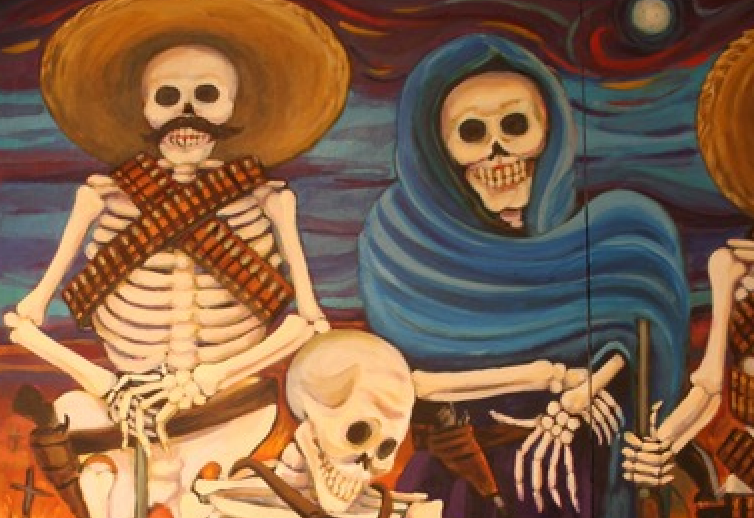Written by Dr. Ricardo Romo
Artist Joe Lopez paints mostly about his Mexican America culture and heritage. His Day of the Dead art piece on the cover is an image connected to his boyhood when he went with his family to the cemetery on All Saints Day to honor the deceased.
Today, San Antonio artists celebrate that holiday not just with cemetery visits, but also with altars, paintings, poetry readings and theatre plays. This year Lopez will send his Day of Dead sketches and drawings that he made over a lifetime to the prestigious Smithsonian Museum in Washington, DC, which is collecting his memorabilia.
Joe Lopez grew up in one of the smallest and most isolated barrios in San Antonio. The barrio, “Barrio Escondido” was next to the famous neighborhood, Cementville, where Mexican workers employed by the giant cement factory and their families lived. That neighborhood disappeared in the 1970s when the plant closed and developers turned the plant into the Quarry Shopping Center.
Lopez remembers Barrio Escondido as being all of two blocks. In the 1940s and 1950s when he was
growing up there, his community had a rural feel to it. He grew up around small farm animals and some families in the neighborhood raised chickens and roosters. He was especially fond of roosters, or Gallos as they were called in Spanish.
Lopez began drawing as a young boy, but in the 8th grade, his second place prize in an art competition allowed him an opportunity to study with a professional artist at the Witte Museum. He had not won, but his teacher, a Catholic nun, was able to convince the art teacher to take him as a student noting that Lopez would be willing to clean the studios after the students left. Barrio Escondido nearly disappeared in the 1970s with the exception of a few small homes tucked in near Broadway and Base Road.
After finishing high school, Lopez painted and earned extra money selling Tee shirts and caps with his favorite phrase, “Puro Gallo,” which means, pure rooster in English. Lopez raised roosters as a young boy and admired their spunk. He painted so many roosters that friends nicknamed him “Gallista.”
In his modest sales and use of the word Gallo, however, he apparently crossed the world largest winery, E&J Gallo Winery. They somehow learned of his “Puro Gallo” products and threatened to sue Lopez for trademark violations. They also demanded he cease to use the word “Gallo” in any shape or form. Lopez and the art community were shocked. In his mind, how could someone copyright a Spanish word, whether it is tierra, taco, cerveza or gallo?
Lopez’ attorney, Filemon Vela, met with representatives of the company and they settled out of court. The Gallo Family had taken on David and in this instance, Goliath gave up on its insane demands and went away. Lopez continued to produce “Puro Gallo” hats and soon decided to open a Latino gallery and studios in Southtown. With the help of his wife Frances, Gallista Gallery was born. Vela, who did not charge Lopez for legal representation, is now the congressman from South Texas. Over the next decade, Lopez continued to paint while the Gallo Family fortune grew to an estimated $10.5 billion.
Joe Lopez operated Gallista Gallery and art studios for nearly twenty years. The entrance to the Gallery had paintings and folk art crafts by local artists. He maintained his own painting studio there and rented exhibition and studio space to many Latino artists. Over nearly two decades, Gallista Gallery hosted monthly art exhibitions, including the addition of altars during the Day of the Dead week.
Artists evolve and art evolves through time. Growing up, for example, one saw few altars in public places in San Antonio. Religious altars were created for use in home settings, and to some extent, in the cemeteries. During the 1980s, Chicano artists began exhibiting altars in public places, such as restaurants, museums and art galleries
Joe has returned to his family homestead and added a studio and gallery to the front of his house. Today he continues to paint, design logos, and sell tee-shirts. In the last sixteen months Lopez has been recognized with solo shows at the University of Incarnate Word and the Beeville Museum of Art. He was also commissioned to complete a mural for the San Pedro Creek renovation project. As for his future plans, he only revealed: “I am proud to be in the barrio where I grew up and happy to be painting full time.”

